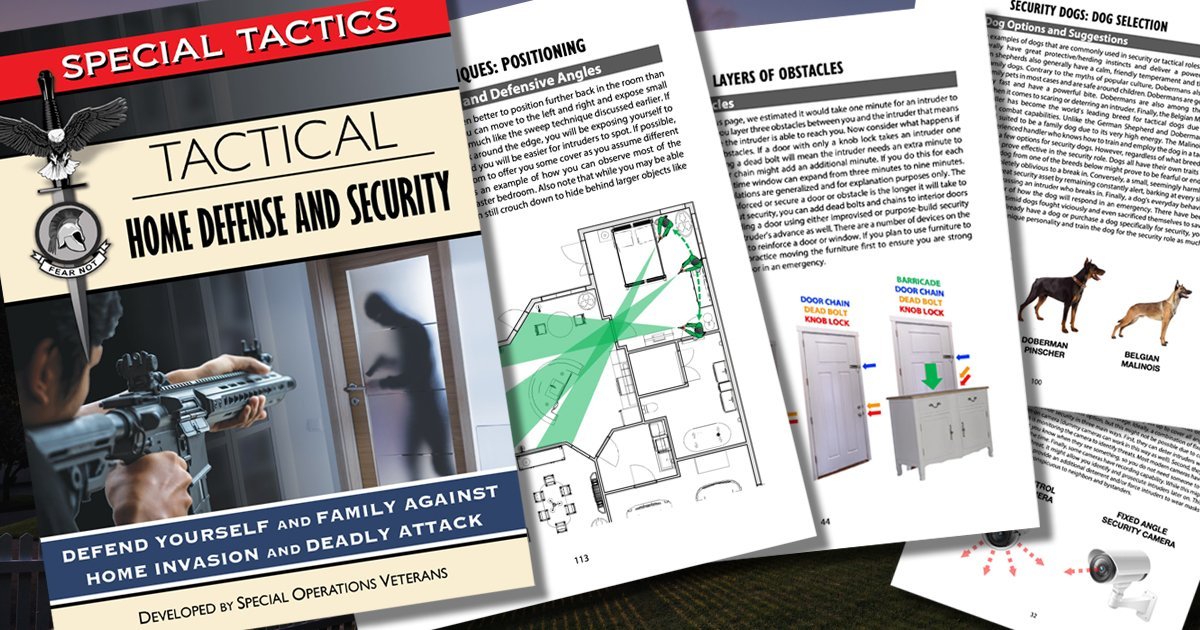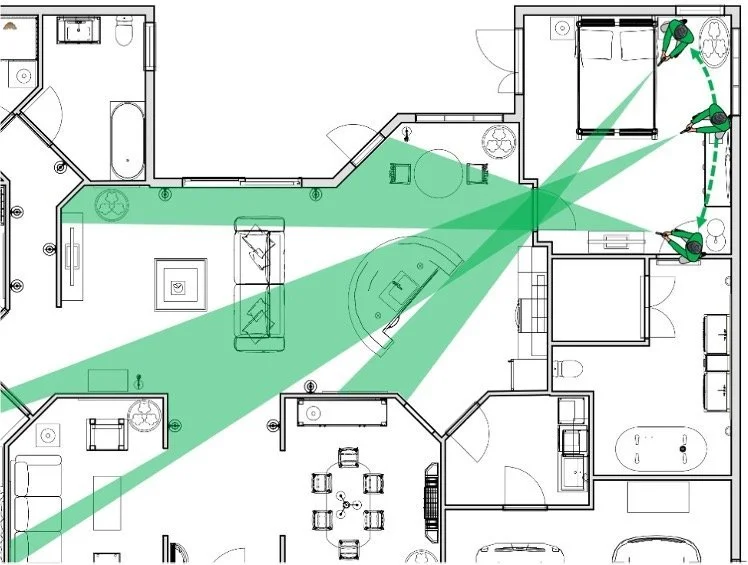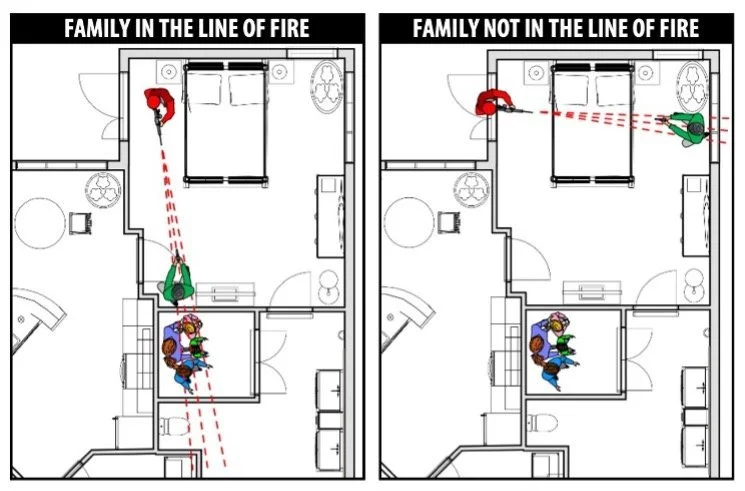Tactical Home Defense: Defensive Positioning
This short article is taken from our new Tactical Home Defense and Security book. The article discusses how to select and establish defensive positions inside your home in response to a hostile attack. We welcome your reactions, comments and ideas on our Facebook page and if you like the article, click below to check out the book on Amazon.
Tactical Home Defense: Defensive Positioning
Our latest book goes into detail on a wide range of topics relating to home defense and security while providing examples of effective tactics and techniques that can help you protect yourself and your family. This article takes a few sections and diagrams from the chapter on armed defensive techniques. The full book goes into more detail on this topic and covers many other topics including community defense planning, threat assessment, improvised weapons and security systems.
Hiding in a Corner vs. Longer Sightlines
Many people mistakenly think that the best way to defend against an intruder is to wait in the corner of a room for the intruder to walk through the door. While this is an option, there are several reasons why it is often not preferable. First, by the time the intruder comes around the corner, he will be at close range and will likely be able to get a few shots off even if you succeed in shooting him. Historical examples of such close-range gun battles generally result in many bullets flying each way before one or both of the shooters goes down. Second, when hiding in a corner, unless you specifically move heavy furniture in front of you, you will likely be exposed and have less cover/concealment. You will also be stuck in one place and have little ability to monitor your surroundings and maintain your situational awareness. It is therefore preferable to identify covered and concealed positions with longer sightlines that allow you to engage the intruder at greater range. It is particularly important to remember that many intruders might run away if shots are fired on them from an unknown position. Therefore, rather than forcing the intruder into a desperate, close-quarters shootout, it is often better to engage him at range, increasing the likelihood that he will run away or at the very least delaying his advance. The green lines below give some examples of longer sightlines within a house while the red lines give examples of shorter sight lines from a corner position.
Fall Back Positions
By engaging intruders at range, you increase your own mobility and situational awareness. You also have the ability to fall back to successive defensive positions as threats advance on your position. Identify some good covered and concealed positions that offer good sightlines along likely threat avenues of approach. With the help of your sensors, identify the direction intruders are coming from, move to your defensive position and engage the intruders. Remain alert for intruders coming from other directions or trying to flank around and surprise you from the side or rear. As intruders approach or flank, fall back to your next defensive position. You may want to fire a few shots to suppress the intruders before falling back. If you are operating with a partner, your partner can cover you as you fall back. By falling back in this way you offer yourself multiple opportunities to engage the intruders at range from behind cover or concealment, making it more likely that they will run away and/or buying you and your family more time to escape, hide or wait for police to arrive. The diagram below gives a general example of how you can establish multiple defensive fall back positions.
Defensive Angles
When defending from inside a room, it is often better to position further back in the room than to stay close to the door. By staying back, you can move to the left and right and expose small slices of the area outside the room at a time, much like the sweep technique discussed earlier. If you position right next to the door and peek around the edge, you will be exposing yourself to much more of the adjacent room at once and you will be easier for intruders to spot. If possible, try to move pieces of furniture within the room to offer you some cover as you assume different defensive angles. The diagram below gives an example of how you can observe most of the family room from positions deeper in the master bedroom. Also note that while you may be able to see far into adjacent rooms, intruders can still crouch down to hide behind larger objects like sofas, cabinets, or countertops.
Keeping Family Members Out of the Line of Fire
As you develop your defensive plan, it is natural for you to end up in a defensive position where the attackers are in front of you and your family is behind you. While this might seem like a good configuration, it is actually dangerous since it puts your family in the line of fire. See the image on the lower left for an example of this. In order to reduce this risk, you may have to separate yourself from your family somewhat. While there is also a degree of risk in leaving your family alone, you must weigh that risk against the risk of drawing hostile fire in the direction of your family. You should take these factors into account when applying any of the techniques or principles in this book. While it can be effective to engage an intruder at range, if you are close to your family you might unknowingly draw hostile fire or the intruders themselves in the direction of your family. In some cases it might be better to try to draw attention away from your family. Remember, that even if you get into a gun fight with intruders and they shoot you, they may then decide to run away. So even if the intruders kill you, if the rest of your family is hidden somewhere else in the house, your family may escape the intruders’ attention and survive.
Technique: Using Glass Paneled Doors in the Defense
While it might seem that glass paneled doors are less preferable in a defensive scenario, they can actually prove extremely useful if you plan to defend your home with a firearm. First, you should purchase a thin, translucent shade for your glass door or choose a door with frosted glass like in the photograph. This sort of shade or glass will be impossible to see through in some situations but easy to see through in others. First, ensure that all lights are out on your side of the door and then ensure there is a strong light source further back in the room on the other side of the door. If possible, make the light difficult to turn off or employ a remote control switch that only you can access. Next, stay as far back from the door as possible. As a backlit intruder gets close to the door you will be able to see him clearly but he will not be able to see you. This will make it almost impossible for the intruder to bypass the lock on the door without getting shot. Emplacing these sorts of shades and light configurations around glass doors in your home can offer you a critical advantage in a gun fight.
We hope you found the short article useful and once again we welcome your reactions, comments or suggestions on our Facebook page where we frequently hold constructive discussions on tactics with people from various tactical backgrounds and experience levels. Also, click below if you would like to check out the full book on Amazon.






